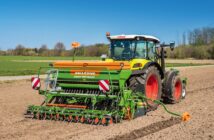Once harvest is over, it can be tempting to put the Combine in the barn and move straight on to the next task but Brocks Wheels and Tyres recommend that an hour or two spent preparing your combine for storage can save a lot of headaches and extra expense next summer.
The first step is to clean the combine. The two best tools for cleaning combines are a pressure washer and compressed air. If you don’t have compressed air, a leaf blower will work.
This is a messy job, but is important because:
1. It helps make combines less attractive to rats and mice
2. It reduces the chance of corrosion
3. Dirt and crop debris, especially in the engine compartments, is one of the biggest causes of combine fires.
First, clean any crop residue and debris with the air compressor. Compressed air is better than a pressure washer as it cleans without leaving moisture in the combine. Make sure you clean dirt from around any bearings and any crop remains that wrap around the shafts during harvest.
Other areas that are sometimes missed are the grain tank and pan, and the engine compartment. Dirt and crop remains in the engine compartment are important to clean. They can be a fire hazard when you start the harvest next season. This is one of the biggest causes of combine fires.
You may need to use the pressure wash. Be careful not to pressure wash any electrical connectors, or any shaft seals and bearings.
While you have the shields off for cleaning, it’s a good time to look for any damaged or worn parts that need repairing.
Combines get used extensively for a short time of the year – this means that they are more likely to have worn or damaged parts.
If you don’t have the time to make repairs on the combine until the quieter months, there’s one thing you should do:
Take the time to make a note of all the things you need to fix or repair on the combine. Six months later, there’s a good chance you or your mechanic will have forgotten them.
How to prepare a combine for storage?
Fuel Tank – To prevent water in the fuel injection system component system, fill the fuel tank with fuel over winter. This stops condensation in the tank. Remember to drain the water separator before use.
Battery – Remove battery and store somewhere warm and dry.
Belts – Loosening belt tension slightly. Don’t remove the tension as this will case the belt to shrink – this causes headaches next season.
Radiator – If you have added water to your radiator, remember to replace it with coolant.
Oils – Do a service check and change fluids if required. Old oil can lead to corrosion while in storage, so it is better to make the oil change before winter.
Engine – When a machine is in storage for a long time, some people recommend sealing exhaust and breather outlets with masking tape. This will help stop condensation caused by changes in temperature. Condensation in the engine can lead to rust. Remember to remove the tape when you start the engine.
Bearings – After you have greased and lubricated, run the combine for 15-20 minutes to distribute the grease inside the bearings.
Tyres – Combine tyres can be expensive to replace, so it’s worth making sure these you store these correctly.
Brocks recommend putting the combine up on blocks to get the tyres off the ground. This is particularly important if the area is damp.
Tyre pressures should be set at the normal pressure and are best kept out of sunlight. Oil or grease on the tyres will damage them so make sure to clean this off.
If you’ve ever gone to start your combine and found that rats or mice have spent the winter months making a home in it or (worse yet) a meal out of the wiring, then you will understand how frustrating that can be.
Electronic repellents – these are sonic or ultrasonic devices that emit a high pitched sound. This is said to deter mice and rats.
Baits and traps – These can be effective. Traps can be a lot of work emptying and resetting them. Bait and poison is a good option, the downside is that rodents will find a hidden spot to curl up and die. Dead rats and mice do not smell pleasant.
Cats – A farm cat or even a Jack Russell Terrier will be effective rodent killers.
Moth balls – This is said to keep mice away, but won’t make them leave if they are already there. It may be worth paying a little extra to go for scented mothballs, as the smell will be quite strong in the cab.
Other solutions – There are many other methods used such as Irish Spring soap, homemade traps, mixtures of old diesel and oil, powdered or granular sulphur.
It’s a busy time of year for arable farmers, but a few hour spend preparing the combine for storage will pay off in the end. A clean and dry combine harvester will mean less wear and tear or damage, less chance of breakdowns or fires during harvest, and ultimately it will increase resale value.





